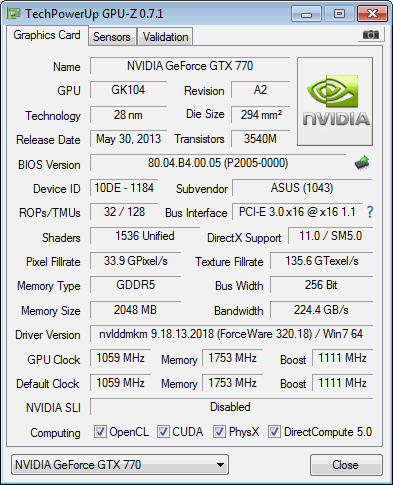ASUS GeForce GTX 770 DirectCU II OC Review
Published by Marc Büchel on 30.05.13Page:
Technical Data / Specifications
With the ASUS GeForce GTX 770 DirectCU II OC you get a card which features a custom PCB as well as a custom cooler. The ASIC quality measured on our sample was 77.7 % which is high considering the average being at 73 % on the cards we had in our hands.
About ASIC quality:

ASUS is using the latest NVIDIA Kepler GK104-425-A2 chip, which is manufactured by TSMC using the latest 28 nanometer process technology. With the GeForce GTX 770 you get eight SMX units which results in 1'536 CUDA cores. Following the specs further, there are 128 TMUs, 32 ROPs, a 256 bit wide memory interface and 2 Gigabyte of GDDR5 memory, which is clocked at 7'000 MHz. In the end there is a memory bandwidth of 224.4 Gigabyte per second. Concerning the GPU's clock speeds it runs at a base clock of 1059 MHz and a boost clock of 1111 MHz. During our tests the highest boost clock we measured was 1149 MHz, which was the same as the average boost clock.
The GTX 770 also supports GPU Boost 2.0. The very first version of GPU Boost stopped overclocking the GPU when a certain power target was hit. This new second version of GPU Boost stops overclocking the card, when a certain temperature is being reached. This makes sense since the temperature is the bigger inhibitor than the power target in most cases. In this case the temperature target is 80 degrees Celsius. In other words, as long as the GPU runs at less than 80°C it will keep overclocking until the maximum frequency has been reached. This is why in our case the average boost clock was 38 MHz higher than the typical boost clock ASUS advertises.

| nVidia GeForce |
GeForce GTX Titan |
GeForce GTX 780 |
ASUS GTX 770 DCU 2 OC |
GeForce GTX 680 |
| Chip | GK110 | GK110 | GK104-425-A2 | GK104 |
| Process | 28 nm | 28 nm | 28 nm | 28 nm |
| Transistors | 7.10 Billion | 7.10 billion | 3.54 billion | 3.54 billion |
| GPU clock | 837 MHz | 863 MHz | 1'059 MHz | 1'006 MHz |
| GPU Boost clock | 876 MHz | 900 MHz | 1'111 MHz | 1'059 MHz |
| Memory | 6'144 MB GDDR5 | 3'072 MB GDDR5 | 2'048 MB GDDR5 | 2'048 MB GDDR5 |
| Memory clock | 1'502 MHz (6'008 MHz) | 1'502 MHz (6'008 MHz) | 1'750 MHz (7'000 MHz) | 1'502 MHz (6'008 MHz) |
| Memory interface | 384 Bit | 384 Bit | 256 Bit | 256 Bit |
| Memory bandwidth | 288'400 MB/s | 288'400 MB/s | 224'400 MB/s | 192'300 MB/s |
| TMUs | 224 | 192 | 128 | 128 |
| Shader Cores | 2'688 (14 SMX) | 2'304 (12 SMX) | 1'536 (8 SMX) | 1'536 (8 SMX) |
| ROPs | 48 | 48 | 32 | 32 |
| Maximum board power | 250 Watt | 250 Watt | 230 Watt | 195 Watt |
| PCB Type | Reference Design | Reference Design | Custom Design | Reference Design |
| Lenght (PCB - Total) | 27.0 - 27.0 cm | 27.0 - 27.0 cm | 27.0 - 27.0 cm | 25.6 - 25.6 cm |
| Cooler | NVIDIA Reference | NVIDIA Reference | ASUS Direct CU II | NVIDIA Reference |
| MSRP | $999 | $649 | $XXX | $499 |
ASUS decided to equip the GeForce GTX 770 DirectCU II OC with their famous DirectCU II cooler. In this case you get three heatpipes which all have a diameter of eight millimeters. Soldered to the heatpipes you find the fin stack which es being provided with fresh air via two fans. Overall this version of the DirectCU II cooler was able to impress. In 2D the fans are inaudble and in 3D the card is still very silent.
A closer look at the PCB shows that ASUS equipped this card with a digital eight phase power design regardin the GPU. When it comes to the memory, you find an analog two phase design. Once more ASUS is using super allow chokes, which provide lower operating temperatures as well as a longer lifespan.
Checking the voltage regulation chip we find a digital multi-phase buck controller ASP1212 from IR (International Rectifier). Furthermore there is an unidentified Richtek 2-phase PWM labelled 02=EL WON taking care of a stable current supply for the the memory.
The memory chips used are made by Samsung and carry the model number K4G20325FD-FC28. They are specified to run at 1'750 MHz (7'000 MHz effective).
Discuss this article in the forums
| Navigate through the articles | |
 ASUS GeForce GTX 780 Review
ASUS GeForce GTX 780 Review |
ASUS GeForce GTX 780 DirectCU II OC Review
 |
|
|




